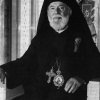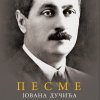Te Right Reverend Dr. Firmilian, Bishop of the Serbian Orthodox Diocese of Midwestern America, was born on the Feast of the Nativity of Christ, according to the Julian Calendar, on the 7th of January 1910. Born into a clerical family in Kaona, Serbia, he was the son of many generations of priests, specifically, born in the family of the protopresbyter Uros Ocokoljich and his mother, Darinka, nee Plazinic, also the daughter of a priest. To the delight of this family, the parents were blessed with the birth of twins, named at baptism, Stanko (later, Firmilian) and Ranko. Stanko was the tenth child.
Having completed his elementary (in the place of his birth) and secondary education (Gymnasium, High School, in Čačak,) young Stanko was admitted into the Orthodox Seminary in Sarajevo, Bosnia, from where he graduated in the year 1930. After having served the Armed Forces of his country, Stanko was married to Nadežda Popović. Following their marriage, Stanko was ordained to the diaconate and then to the priesthood, being assigned as assistant to his father, protopresbyter Uroš, in the Village of Kaona. He was ordained to priesthood in 1930 by Bishop Jefrem Bojović, brother of well-known Vojvoda Petar Bojović. Tragically, within the first year of his marriage, Father Stanko lost both his wife and son, during childbirth.
His life was to take on a profound new meaning. Education became the goal of the widowed priest Stanko. Desiring to further his own education, he resumed his theological studies at the University of Belgrade. Simultaneously, appointed by the Ministry of Education, he assumed the role of an educator by accepting a post teaching religion in the public school systems in Belgrade.
After graduating from the School of Theology at the University of Belgrade, Presbyter Stanko was appointed professor of Patristics and Greek at the then Seminary in Cetinje, Montenegro. He received the monastic tonsure at the Monastery of St. Joakim of Osogovo in the jurisdiction of the Metropolitanate of Skoplje under Metropolitan Josif.
The young Hieromonk Firmilian came to the United States of America in the year 1940, together with, and at the request of the then Bishop Dionisije (Milivojević). In addition to having served the youngest diocese of the Serbian Orthodox Church in America and Canada, as its administrative secretary, the energies of the Father Firmilian were incorporated into the pastorates of many of the largest Serbian communities in America: “Ravanica” in Detroit, Michigan (from October 1941); Holy Resurrection in Chicago, IIlinois; St. George and St. Sava in Pittsburgh, Pennsylvania and the most prestigious St. Sava Pro-Cathedral in New York City. He was also a member of the Monastery brotherhood.
During the Second World War, Father Firmilian was sent to serve the parochial needs of the Serbian Community in London, England. Here it was, that he was named personal chaplain to the Karageorgevich Dynasty, specifically by His Majesty Peter II, exiled King of Yugoslavia.
Returning to the United States of America, the then Syngelos Firmilian was elevated to the rank of archmandrite. Perhaps it may be stated that of all of the pastorates encountered by Father Firmilian, nothing was to remain as dear to his heart as the Monastery of St. Sava in Libertyville.
In addition to his administrative capacities, as an established educator, he taught at the former St. Sava Seminary, which was housed at the Monastery. He was responsible for the promotion of the publication of many of Bishop Nicholai (Velimirović’s) literary works. While residing at the Monastery, he obtained his Doctorate in Philosophy, from the Department of History, at the eminent University of Chicago. The subject of his doctoral dissertation was the Legal Codex of the Serbian Emperor Dushan.
Soon after the purchase of the Shadeland Diocesan Estate in Springboro, Pennsylvania, archimandrite Firmilian was appointed its director. In this capacity, he sponsored the promotion of the establishment of a Charity Home, dedicated to St. Sava; a Children’s Summer Camp and a fully operative farm.
Having been instrumental in the 1945 formation of the National Federation of the Circles of Serbian Sisters, the same archimandrite Firmilian was eventually appointed, by the then Bishop, to serve as its capable spiritual advisor.
While tending to the pastoral needs, of what he built up to be the largest Serbian Community in the United States, Fr. Firmilian, Dean of the New York City Pro-Cathedral of St. Sava, assumed numerous other responsibilities. Again, as a never-failing educator, Dr. Firmilian resumed teaching, now at St. Vladimir’s Theological Seminary in New York City. As professor at this graduate school of theology, Dr. Firmilian taught Hagiology and both Western and Serbian Ecclesiastical Histories. He was also appointed Dean of Serbian Students. As liaison to the Bishop, he represented his Church before the World Council of Churches. Together with Archbishop Iakovos of the Greek Orthodox Church, he was instrumental in the formation of the Standing Conference of Canonical Orthodox Bishops in the Americas (SCOBA). It was he, who was then named as its first administrative secretary.
Realizing the invaluable dedication of archimandrite Firmilian to both his Church and to his people, the Holy Assembly of Bishops of the Serbian Orthodox Church, on July 27, 1963, elected the same as Bishop of the newly-created Diocese of Midwestern America. The then Bishop-elect Firmilian was consecrated, as the first Hierarch of this nascent Diocese, in the Cathedral Church of St. Sava in Milwaukee, Wisconsin, on August 1, 1963. The officiating hierarchs were Bishop Chrysostom of Branicevo Diocese and Bishop Stefan (Lastavica) of the Eastern American Diocese.
By the decision of the Holy Bishop’s Assembly, the See of the Diocese was to be at St. Sava Monastery in Libertyville, Illinois. Bishop Firmilian could not occupy the Diocesan sea because Bishop Dionisije, who rejected the decision of his suspension and division of the Diocese, refused to vacate the See. That caused disputes and protection from the American Civil Courts. The litigation was lengthy and exhausting. Millions of dollars were spent on trials. Bishop Firmilian followed and executed the decisions of the Holy Bishops’ Assembly.
The new situation in the Serbian Church required new organization of the Church offices. Along with Diocesan offices, the Central offices were established. Thus in 1967 Bishop Firmilian, informed the Holy Synod: “Since the court litigation was ongoing, the Constitution of the American Canadian Diocese could not have been changed. To have better coordination, we have organized joint offices: the Episcopal Council was organized at the Church-Laity Assembly in Detroit 1964 and consists of Diocesan Bishops from three Dioceses. The presiding Bishop is one on whose territory a meeting is held; the Central Council of the Serbian Orthodox Church in America and Canada, which consists of three Diocesan Bishops, Bishop’s deputies, Vice Presidents of the Diocesan Councils and two lay members from each Diocese.” This structural organization remained in effect until the creation of the Constitution for the three Dioceses in 1981, when the existing organizational structure was constitutionalized.
Never wavering in his assurance of the victory of truth, Bishop Firmilian lived to see his beloved Monastery of St. Sava returned to the Church. Himself, returning again at the Monastery in 1979, Bishop Firmilian labored ceaselessly to restore the memory of the forgotten Bishop Mardarije (Uskoković), founder of the Monastery and first Serbian Orthodox Bishop of America and Canada, and to complete his, “Mardarije’s Dream,” by renovating and enlarging the Monastery Church to its present conception.
After celebrating both the Nativity of the Lord and his own birthday, in the year 1984, Bishop Firmilian suffered a series of heart attacks and several strokes. Valiantly, carried by his faith, and the outpouring love and prayers of the faithful from all jurisdictions, Bishop Firmilian overcame a coma, once again being able to delight in the Monastery that he loved so well.
Having entered into eternal repose on November 2nd 1992, Bishop Firmilian was laid to rest outside of the Monastery Church of Saint Sava, immediately behind the grave of the Holy Bishop Nicholai (Velimirović).
Source: Rt. Rev. Bishop Irinej of Eastern America (Dobrijevic, Mirko), "Marking the 25th Anniversary of the Episcopal Consecration of His Grace, The Right Reverend Firmilian, Doctor in Philosophy, Сerbian Orthodox Bishop of Midwestern America", 1988 Calendar of the Serbian Orthodox Church in the United States of America and Canada, Libertyville, Illinois, 1988, pp. 68-72.
Епископ Фирмилијан (Оцокољић)
Рођен је у Властељицама (Драгачево) 25. 12. 1909. године. Његов отац Урош Оцокољић службовао је као свештеник у цркви каонској, бавио се политиком и био, поред осталог, председник Каонске земљорадничке задруге, а мајка Даринка, рођена Плазинић, бринула је о домаћинству.
Родитељи су били поносни на свог сина, који се од вршњака издвајао бистрином и готово урођеном мудрошћу. Такав је био и као основац, такав и као гимназијалац. Након завршетка четири гимназијска разреда у Чачку, учио је богословију у Сарајеву, коју је завршио 1931. године.
Пошто је рукоположен за свештеника, службовао је као капелан свога оца у Каони, где је остао до јануара 1934. године, када је прешао у Крагујевац. Ту му је, исте године, заједно са новорођеним дететом, на порођају, преминула супруга Надежда. Све ово га је потресло, па је напустио Крагујевац и отишао у Београд, где је постављен за вероучитеља у Основној школи "Свети Сава". Истовремено је студирао теологију на Београдском универзитету, где је дипломирао 1938, а потом постављен за суплента Богословије на Цетињу. Касније ће предавати веронауку у Женској гимназији у Београду.
Замонашио се 1939. године у манастиру Острог и том приликом добио је име Фирмилијан.
Синод Српске православне цркве упутио га је 1. марта 1940. године у Сједињене Америчке Државе. Постављен је за секретара Америчко-канадске епархије, једине епархије Српске православне цркве у том делу света. Посао је обављао крајње савесно, а монашки чин и ризу достојанствено је и богоугодно носио.
У току Другог светског рата живео је у Енглеској, где је био дворски свештеник краља Петра II Карађорђевића, кога је и венчао 1944. године. У то време унапређен је у чин архимандрита.
На Оксфордском универзитету слушао је 1945. године историју и философију. По повратку у Сједињене Америчке Државе докторирао је 1. марта 1963. на Универзитету у Чикагу са темом "Законик Цара Душана". Једно време предавао је историју на Академији Светог Владимира, а службовао је и у црквама(Чикаго, Детроид, Питсбург). Потом је био свештеник у Либертвилу, где се налазило седиште Америчко-канадске епархије и владике Дионизија Миливојевића.
Уследио је расцеп у Српској православној цркви. Америчко-канадска епархија подељена је 10. маја 1963. године. За једног од епископа, средњезападноамеричког, постављен је управо Фирмилијан Оцокољић. Седиште му је било у Либертвилу. Епископ Дионисије, који је рашчињен, није прихватио овакве одлуке Синода СПЦ. Он није хтео да преда дужност Фирмилијану, па су настали спорови. Ипак, Фирмилијан Оцокољић уведен је у дужност, а рашчињени епископ Дионисије основао је Слободну српску православну цркву.
Наравно, Фирмилијану Оцокољићу није одговарао расцеп у СПЦ, па је настојао да последице буду што мање. Због тога је походио цркве и у Енглеској, и у Француској, и у Аустралији. Он је, иначе, 10. маја 1965. године, након смрти епископа источноамеричко-канадског Саве, постављен и за администратора те епархије. Ову одговорну дужност обављаће две године.
Први пут после одласка у САД, у мају 1967. године боравио је у Београду. Тада је посетио и своју родбину у Властељицама.
Године 1968. представљао је СПЦ на Ламбетској конференцији у Лондону.
Сем бављења црквеним пословима, много је и на друге начине учинио на очувању идентитета српског живља у Америци. Организовао је светосавске и друге прославе, а на његову иницијативу написане су и две значајне књиге: "Историја модерне Србије 1804-1918" и "Историја Срба у Америци". Иницијатор је отварања Хиландарског одељења на Универзитету у држави Охајо(САД). И сам је писао, нарочито о догађајима из историје српског народа и СПЦ. У листу "Православље" објавио је запажену расправу "Из српске историје-Педесетогодишњица првог српског црквено-народног сабора у Америци".
У јануару 1984. године доживео је срчани удар и смештен у болницу у Чикагу. Уследио је мождани удар. Срби у Америци жалили су га и упућивали му жеље за оздрављење. Нису заборављали његове заслуге, оне које су, рецимо, 25. јануара 1971. исказане при прослави четрдесете годишњице свештеничке службе епископа Фирмилијана у Чикагу. "Православље" ће, тим поводом, писати да је "епископ др Фирмилијан један од најугледнијих личности у српским црквеним круговима у Америци и један од ретких људи који познаје прилике, историју и живот Срба у САД".
Због болести разрешен је епископске дужности 14. јуна 1987. Умро је 2. новембра 1992. године у Либертвилу, где је и сахрањен.
Извор: Др Бранко Ковачевић, Ника-Никола Стојић и Радован М. Маринковић, "Драгачевци у науци и уметности I", Чачак, 1993.





